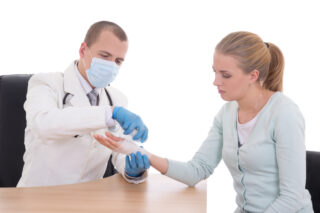
8230 Old Courthouse Road
Suite #430
Tyson’s Corner, VA
1-833-MY-BURNS

More Legal and Health Articles
Mastering the Art of Dressing Burn Injuries

Dressing burn injuries correctly is essential for promoting healing, preventing infection, and minimizing complications. By following these steps and seeking appropriate medical attention when necessary, individuals can effectively manage burn injuries and support the healing process. Remember to always prioritize safety and consult with a healthcare professional for guidance on burn care and treatment.
Dressing burn injuries correctly is a crucial aspect of burn care that can significantly impact the healing process and minimize complications. Whether it’s a minor burn from touching a hot surface or a severe burn requiring medical attention, proper dressing techniques can provide comfort, promote healing, and reduce the risk of infection. In this blog post, we’ll explore the essential steps and considerations for dressing burn injuries effectively.
1. Assess the Severity of the Burn
Before applying any dressings, it’s important to assess the severity of the burn injury. Burns are typically categorized into three degrees:
- First-degree burns: These affect only the outer layer of the skin (epidermis) and usually result in redness, pain, and swelling. First-degree burns can often be managed with simple first aid measures at home.
- Second-degree burns: These involve damage to the outer layer of skin (epidermis) and the underlying layer (dermis) and may cause blistering, severe pain, and redness. Second-degree burns may require medical attention depending on their size and location.
- Third-degree burns: These are the most severe type of burn injury, extending through all layers of the skin and potentially affecting deeper tissues, nerves, and blood vessels. Third-degree burns often appear charred or white and require immediate medical attention.
2. Cool the Burn
For minor burns, the first step in dressing is to cool the burn under cool (not cold) running water for at least 10-20 minutes. This helps to reduce pain, inflammation, and further tissue damage. Avoid using ice, as it can cause additional skin damage.
3. Cleanse the Wound
After cooling the burn, gently cleanse the wound with mild soap and water to remove any dirt, debris, or bacteria. Be careful not to scrub the burn, as this can cause further irritation and pain. Pat the area dry with a clean, soft towel or allow it to air dry.
4. Apply an Antimicrobial Ointment
For minor burns, apply a thin layer of over-the-counter antimicrobial ointment, such as bacitracin or silver sulfadiazine, to the wound to help prevent infection and promote healing. Be sure to follow the instructions on the product label and avoid applying excessive amounts of ointment.
5. Cover with a Non-Adhesive Dressing
Once the burn is cleaned and treated with ointment, cover it with a non-adhesive dressing, such as sterile gauze or a non-stick dressing pad. Avoid using adhesive bandages or tapes directly on the burn, as they can cause further trauma and impede healing. Secure the dressing in place with medical tape or a bandage wrap, ensuring that it’s snug but not too tight.
6. Change Dressings Regularly
It’s important to change dressings regularly to keep the burn clean and monitor its healing progress. Depending on the severity of the burn and the healthcare provider’s recommendations, dressings may need to be changed daily or as directed. When changing dressings, be gentle to avoid disrupting any new skin growth or causing pain.
7. Seek Medical Attention for Severe Burns
For second-degree burns larger than three inches in diameter, third-degree burns, or burns that cover sensitive areas such as the face, hands, feet, or genitals, seek immediate medical attention. These types of burns may require specialized care, including debridement, wound irrigation, and possibly skin grafting.
Attorney Paul Samakow has a national practice representing burn injury survivors. If you or a loved one has suffered a burn injury, please call 1-833-MY-BURNS and be sure to visit his website www.nationalburnattorney.com for additional resources.
Other Articles You May Find of Interest...
- 7 Important Steps to Maintain Motivation After an Injury
- Understanding Pain and Suffering in Personal Injury Claims
- A Guide to Choosing a Professional and Established Law Practice
- Reasons To Hire a Car Accident Lawyer After Your Crash
- Understanding the Impact of Spinal Cord Injuries on Victims and Their Families
- How to File a Brain Injury Lawsuit in Atlanta
- Steps Lyft Sexual Assault Victims Should Take
















